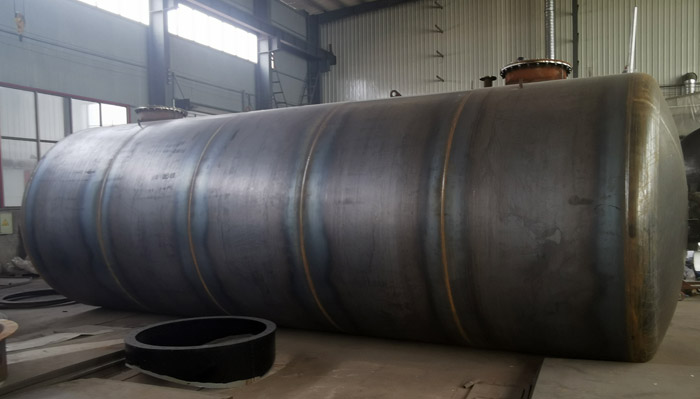Product Category
Case analysis of double-layer oil tank operation failure
Date: Jul 07, 2020

Even the double-layer oil tank equipment with excellent performance will inevitably have abnormal conditions during long-term use, such as fire, overflow tank, oil leakage, water leakage, deflation, bulging, etc. Effective treatment of these problems will inevitably seriously affect the normal use of the entire pressure vessel and the smooth production of the enterprise. Henan Jianshen Company combined with many years of experience in the industry, conducted a detailed analysis of the causes of the above-mentioned types of problems, and put forward corresponding treatment methods for reference.
● on fire
Causes: Illegal hot work or the introduction of fire; sparks caused by metal impact on the operation of the pressure vessel; electrical overload operation or short circuit; crude oil running, running, dripping, leakage; static charge discharge facility failure and lightning discharge; flammable Spontaneous combustion; spread of accidental fire.
Treatment method: stop all operations of the fired double-layer oil tank; cover the oil surface with the fire-fighting equipment and cool the tank wall with water; the oil tank of the intermediate pump station is on fire, and the pressure over station process is changed; the oil tank of the first station is on fire, if the floating roof The tank or the tank with the damaged top cover is poured out of the oil in the oil tank. At this time, the oil temperature is controlled within 90 ℃; the adjacent tank adopts the inverted tank, cooling the tank wall, building fire embankment, foam or fireproof items for each orifice Blocked; to prevent the spread of fire oil.
●Overflow tank
Causes: Failure to pour the tank in time; stop the pump at the intermediate station to pour the process in time; fail to grasp the changes in the amount of incoming oil; the heating temperature is too high to cause the water accumulated in the bottom of the double-layer oil tank to boil; the liquid level gauge fails.
Treatment method: stop the oil intake and pour the tank immediately. If the station cannot lift or pour the tank, the pressure should be reversed or the closed process should be reversed; contact the upper and lower stations to adjust the oil delivery of the pressure vessel; stop heating and reduce the temperature of the tank; repair fluid Bit meter. ●Oil leakage, water leakage
●Oil leakage, water leakage
Causes: Freezing and cracking of oil tank valves or pipelines; damaged seals; corrosion and perforation of tank bodies; leakage of heating coils.
Treatment method: immediately pour the tank; the overpressure process of the intermediate station or increase the throughput; clear the tank to detect and repair; during the accident, the site should be controlled to prevent fire accidents in the double-layer oil tank.
●deflated
Causes: Breathing valve and safety valve are frozen or rusted; flame arrester is blocked.
Treatment method: Check whether the breathing valve and safety valve are frozen or rusted on the tank, and whether the flame arrester of the double-layer oil tank is blocked; stop the overpressure process of the reverse pressure of the intermediate discharge station.
●Drum kit
Cause: The breathing valve and safety valve of the double-layer oil tank are frozen or rusted; the flame arrester is blocked; the oil in the upper part of the tank is frozen and frozen, and the lower part is heated.
Treatment method: stop the oil intake; the reverse pressure of the intermediate station over the station process; heat the condensate from top to bottom.
● on fire
Causes: Illegal hot work or the introduction of fire; sparks caused by metal impact on the operation of the pressure vessel; electrical overload operation or short circuit; crude oil running, running, dripping, leakage; static charge discharge facility failure and lightning discharge; flammable Spontaneous combustion; spread of accidental fire.
Treatment method: stop all operations of the fired double-layer oil tank; cover the oil surface with the fire-fighting equipment and cool the tank wall with water; the oil tank of the intermediate pump station is on fire, and the pressure over station process is changed; the oil tank of the first station is on fire, if the floating roof The tank or the tank with the damaged top cover is poured out of the oil in the oil tank. At this time, the oil temperature is controlled within 90 ℃; the adjacent tank adopts the inverted tank, cooling the tank wall, building fire embankment, foam or fireproof items for each orifice Blocked; to prevent the spread of fire oil.
●Overflow tank
Causes: Failure to pour the tank in time; stop the pump at the intermediate station to pour the process in time; fail to grasp the changes in the amount of incoming oil; the heating temperature is too high to cause the water accumulated in the bottom of the double-layer oil tank to boil; the liquid level gauge fails.
Treatment method: stop the oil intake and pour the tank immediately. If the station cannot lift or pour the tank, the pressure should be reversed or the closed process should be reversed; contact the upper and lower stations to adjust the oil delivery of the pressure vessel; stop heating and reduce the temperature of the tank; repair fluid Bit meter.

Causes: Freezing and cracking of oil tank valves or pipelines; damaged seals; corrosion and perforation of tank bodies; leakage of heating coils.
Treatment method: immediately pour the tank; the overpressure process of the intermediate station or increase the throughput; clear the tank to detect and repair; during the accident, the site should be controlled to prevent fire accidents in the double-layer oil tank.
●deflated
Causes: Breathing valve and safety valve are frozen or rusted; flame arrester is blocked.
Treatment method: Check whether the breathing valve and safety valve are frozen or rusted on the tank, and whether the flame arrester of the double-layer oil tank is blocked; stop the overpressure process of the reverse pressure of the intermediate discharge station.
●Drum kit
Cause: The breathing valve and safety valve of the double-layer oil tank are frozen or rusted; the flame arrester is blocked; the oil in the upper part of the tank is frozen and frozen, and the lower part is heated.
Treatment method: stop the oil intake; the reverse pressure of the intermediate station over the station process; heat the condensate from top to bottom.
Last article:
Next article:
Send Your Inquiry
We not only provide a good product, but also provide high quality service. If you are interested in our products,
you can contact us in the following ways.
you can contact us in the following ways.















































































































